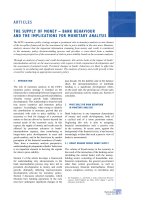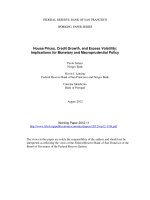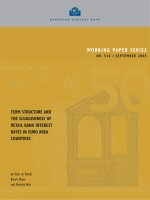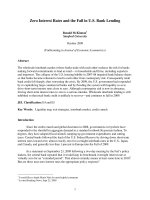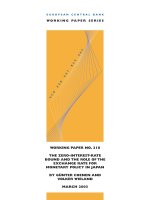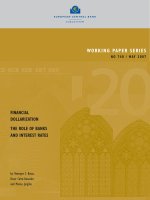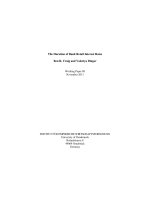The Zero Bound on Nominal Interest Rates: Implications for Monetary Policy potx
Bạn đang xem bản rút gọn của tài liệu. Xem và tải ngay bản đầy đủ của tài liệu tại đây (38.77 KB, 8 trang )
27BANK OF CANADA REVIEW • WINTER 2007–2008
The Zero Bound on Nominal
Interest Rates: Implications for
Monetary Policy
Claude Lavoie and Stephen Murchison, Research Department
• The lower bound on nominal interest
rates is typically close to zero, since
households can earn a zero rate of
return by holding bank notes.
• The average inflation rate, the size of
the shocks hitting an economy, the
formation of inflation expectations, and
the conduct of monetary policy itself all
influence the risk of hitting the zero
bound. The balance of evidence
suggests a small risk of encountering
the zero bound when average inflation
is at least 2 per cent.
• Central banks considering an inflation
target much below 2 per cent must
factor in possible difficulties that the
zero bound on nominal interest rates
might present for the conduct of
monetary policy.
rice stability is generally viewed among both
academics and practitioners as the most
appropriate long-run objective for monetary
policy. In Canada, the benefits of low, stable,
and predictable inflation are clear. Since the Bank of
Canada adopted an explicit inflation target in 1991,
both the level and volatility of short- and long-maturity
interest rates have declined. In addition, real growth
has been higher and more stable than in previous dec-
ades (Longworth 2002). Monetary policy aimed at
achieving low and stable inflation, in conjunction with
sound fiscal policy, has resulted in a stronger, more
resilient economy that is better equipped to weather
shocks.
Canada’s strong economic performance since the
adoption of a 2 per cent inflation target raises the
question of whether the Bank of Canada should lower
the target further. Even when measurement error is
factored into the consumer price index (CPI) (see
Rossiter 2005), 2 per cent inflation does not corre-
spond to true price stability. Targeting a rate of inflation
closer to zero may further reduce resource misallo-
cations resulting from inflation uncertainty and reduce
the frequency of price changes, thereby lowering
menu costs.
1
In addition to the possible transition
costs associated with a reduction in the target, how-
ever, two main arguments have traditionally been
advanced against the idea of targeting a very low rate of
inflation. The first stems from the concern that it may
be more difficult to adjust real wages downwards when
inflation is low because this would also entail a
1. Interpreted literally, the term menu costs refers to the costs associated with
having to reprint menus each time a restaurant updates its prices. The term is
typically used more broadly to describe costs associated with changing prices
in general.
P
28 BANK OF CANADA REVIEW • WINTER 2007–2008
reduction in the nominal wage, and workers may be
reluctant to accept such reductions (Akerlof, Dickens,
and Perry 1996; Fortin 1996; and Fortin et al. 2002).
2
The second argument is that central banks could
encounter difficulties conducting monetary policy
in a very low-inflation environment because nominal
interest rates cannot go below zero (Summers 1991).
Canada’s strong economic
performance since the adoption of a
2 per cent inflation target raises the
question of whether the Bank should
lower the target further.
Recent experience in Japan, in which nominal short-
term interest rates remained close to zero for more
than seven years and real annual growth in gross
domestic product (GDP) averaged just 1.7 per cent
over the same period, suggests that the zero interest
rate bound remains a significant and relevant practi-
cal issue for monetary policy.
In this article, we examine the impact of the zero bound
on nominal interest rates, the likelihood that the con-
straint will bind, the ways that monetary policy can
reduce this likelihood, and alternative policies to stim-
ulate the economy when the zero bound binds. We
begin by reviewing the underlying mechanism of the
zero-bound problem and then assess the risk of hitting
the zero bound, including the potential implications.
In the following section, we review the main factors
that influence this risk, with special emphasis on the
role played by monetary policy design. We then
discuss some policy alternatives that are available to
the central bank for stimulating the economy when
interest rates are stuck at zero. In the final section, we
draw some conclusions on the general implications of
the zero bound for monetary policy in Canada.
Why Are Nominal Interest Rates
Bounded at Zero?
Central banks typically implement monetary policy
by adjusting a very short-term nominal or “money”
interest rate, such as the overnight rate in Canada. The
2. Crawford and Wright (2001) argue that while downward nominal wage
rigidities exist, the magnitude of their real effects is extremely small.
nominal interest rate on an asset refers to the rate
of return expressed in money terms, so a one-year,
$100 bond with a rate of 6 per cent will pay the holder
$106 at maturity. But in an economy with positive
inflation, the purchasing power of money will decline
over the course of that one-year period. The actual
increase in the purchasing power of goods and services
associated with the bond is referred to as the real
interest rate. This relationship is summarized by the
Fisher identity: The real interest rate is equal to the
nominal interest rate minus the expected inflation
rate:
Real Rate = Nominal Rate - Expected Inflation
Since households in the economy derive utility from
the purchases of goods and services, it is the real rate
of interest that is most relevant to their economic deci-
sions. Therefore, monetary policy actions will influence
demand only to the extent that adjustments to the
nominal interest rate feed through to the real interest
rate. In the case of an inflation-targeting central bank
like the Bank of Canada, the task of monetary policy is
to reduce real short-term interest rates when economic
events, or shocks, occur that cause inflation to fall
below the target and, symmetrically, to raise real interest
rates when shocks cause inflation to go above the target.
This suggests that the normal conduct of monetary
policy involves a degree of variation in the level of
short-term interest rates over a business cycle. Of
course, the larger the shock, all else being equal, the
larger will be the adjustment to interest rates that is
required to return output to potential and inflation to
the target over a reasonable time horizon. In response
to a significant deterioration in economic conditions, a
deep recession, for example, the central bank may
wish to lower the nominal interest rate below zero.
Since households can always earn a zero rate of return
by holding bank notes, however, no rational person
would willingly agree to purchase a security yielding
a negative nominal return. In practice, therefore, the
lower bound on nominal interest rates is typically very
close to zero,
3
and this bound may prevent a central
bank from reducing the real interest rate sufficiently to
return the economy to its potential level over the
desired time horizon.
4
3. Technically, the lower bound would literally be zero only in a world where
there are no costs to holding cash. As discussed in Yates (2004), to the extent
that there are variable costs associated with holding money, such as monitor-
ing and storage costs, then the lower bound on nominal interest rates would
be slightly negative.
4. For a comprehensive review of the literature on the zero bound on nominal
interest rates, see Yates (2004) and Amirault and O’Reilly (2001).
29BANK OF CANADA REVIEW • WINTER 2007–2008
Whether the zero bound causes significant short-run
damage to an economy will depend on what happens
once interest rates reach zero. In a benign scenario,
with no further negative shocks, low real interest rates
may gradually return output to potential and inflation
to the target, albeit more slowly than desired. Suppose,
instead, that a significant negative shock to demand
hits the economy, and the central bank finds itself
unable to further reduce real interest rates. Recall-
ing the Fisher identity, if the nominal rate is stuck at
zero, any shock that lowers inflation expectations will
raise the real interest rate. A deflationary spiral occurs
when high real interest rates depress demand, which
further reduces inflation expectations, and so on. The
result can be a long period of weak demand growth
and deflation.
Historical Estimates of the Risk of
Hitting the Zero Bound
While there is no debating the existence of a lower
bound on nominal interest rates, its relevance to policy-
makers depends entirely on the probability that it will
limit the central bank’s ability to reduce real interest
rates. Owing to limited historical experience with
interest rates close to the zero bound, probability esti-
mates are typically computed via simulations with
economic models.
In practice, the lower bound on
nominal interest rates is typically
very close to zero.
Results for Canada are reported by Lavoie and Pioro
(2007); Babineau, Lavoie, and Moreau (2001); Black,
Coletti, and Monnier (1998); and Cozier and Lavoie
(1994). For an average inflation rate of 2 per cent
and an average real interest rate of 3 per cent, prob-
ability estimates of the nominal interest rate equal-
ling zero range from about 1 per cent to 4 per cent.
In addition, Lavoie and Pioro (2007) report that, with
an inflation target of 2 per cent, the probability of fall-
ing into a deflationary spiral is effectively zero (see
Table 1). As we discuss in the next section, these prob-
abilities depend importantly on a number of factors,
including the average rate of inflation in the economy.
Therefore, for a central bank considering an inflation
target that is significantly lower than 2 per cent, the
threat of the zero bound cannot be ignored.
Factors That Influence the Risk of
Hitting the Zero Bound
The factors affecting the probability of hitting the zero
bound can be divided into two categories: those that
influence the mean, or average, level of the interest
rate and those that affect its volatility, or variation,
around that mean. As we discuss in detail below, the
conduct of monetary policy in general can have an
important bearing on both the mean and the variance
of nominal interest rates.
With an inflation target of 2 per cent,
the probability of falling into a
deflationary spiral is effectively zero.
Beginning with the first set of factors, the Fisher identity
discussed in the previous section stipulates that the
average nominal interest rate over a given period of
time is equal to the average real interest rate plus the
average expected inflation rate, where the latter should
be approximately equal to the inflation target, provided
the target is viewed as credible. The lower the inflation
target, the lower will be the nominal interest rate, on
average, and the higher will be the likelihood that the
zero bound is encountered. Lavoie and Pioro (2007)
estimate that targeting zero, rather than 2 per cent,
inflation would increase the likelihood of hitting the
zero bound approximately threefold, from 3.8 to
12.1 per cent (see Table 1). Moreover, not only does the
likelihood increase as the inflation target is reduced,
but it increases at an increasing rate, meaning that the
T
able 1
P
erformance of Various Policy Rules under Inflation
T
argeting
A
verage Degree of Probability Probability of
(
targeted) history- of hitting deflationary
i
nflation rate dependence zero bound spiral
2
per cent Low 17.0 0.0
High 3.8 0.0
0
per cent Low 35.4 0.2
High 12.1 0.2
N
ote: Results taken from Lavoie and Pioro (2007)
30 BANK OF CANADA REVIEW • WINTER 2007–2008
the response of longer-maturity interest rates to a
change in monetary policy will depend on how long
the change is expected to last. All else being equal,
movements in short-term interest rates that are per-
ceived by the market to be long lasting will exert a
greater influence on longer-term nominal rates.
When we combine the Fisher identity with the expec-
tations theory of the term structure, we see that, for
a given reduction in the policy interest rate, longer-
maturity real interest rates will decline by more if the
reduction is perceived to be long lasting and if inflation
expectations rise. From the point of view of a central
bank wishing to avoid the zero bound, this is the
best-case scenario, since even a small reduction in the
nominal interest rate can be highly stimulative to the
economy.
Central banks seeking to minimize
the probability of encountering the
zero bound should credibly commit to
a history-dependent monetary policy.
On the basis of this reasoning, Woodford (1999) argues
that central banks seeking to minimize the probability
of encountering the zero bound should credibly commit
to a history-dependent monetary policy, i.e., the central
bank must convince the public that interest rate reduc-
tions implemented today will remain in place well
into the future. In other words, the current level of the
short-term policy interest rate will be highly correlated
with its level in previous periods. Clearly, this will act
to lower longer-maturity nominal interest rates through
the expectations theory of the term structure. Provided
that private sector inflation expectations are forward
looking in nature,
6
however, such a history-dependent
policy will also act to raise longer-term inflation expec-
tations, thereby further reducing the real interest rate.
The reasoning is straightforward: Interest rate cuts
that are viewed as long lasting will be more stimulative
to the economy and will therefore raise expectations
of future inflation more than cuts that are perceived as
highly transitory.
6. Inflation expectations are said to be forward looking if they are based on a
particular view of the future state of the economy, such as the future level of
demand relative to long-run supply. This contrasts with adaptive expecta-
tions, whereby agents base their view of future inflation on the level of infla-
tion over the recent past.
relationship is non-linear. Consequently, the constraint
created by the zero bound on nominal interest rates
has been used as an argument against targeting a very
low level of inflation, typically below 1 or 2 per cent.
The second set of factors that are important for deter-
mining the probability of hitting the zero bound are
those that affect the variability of short-term nominal
interest rates. As discussed in the previous section,
central banks adjust short-term interest rates in an
effort to achieve their target(s) in response to unex-
pected economic developments or shocks. Therefore,
the degree of variation in short-term nominal interest
rates generated by monetary policy actions will depend
on the variability of the shocks faced by the economy.
All else being equal, the higher the variance of shocks,
the more volatility is required in interest rates in order
to achieve the target.
While the variance of economic shocks is clearly an
important determinant of interest rate volatility, it is
not the sole factor. The manner in which private sector
expectations are formed, coupled with the means by
which monetary policy actions are implemented and
communicated, can have a significant influence on the
variability of short-term interest rates for a given vari-
ance of shocks and the central bank’s objective.
Central banks have direct control over a very short-
term nominal rate, such as the overnight rate, whereas
it is the market-determined real interest rate across the
yield curve that is most relevant to aggregate demand
and inflation. The impact on the economy of a given
change in the nominal short rate will depend, therefore,
on the extent to which it is reflected in longer-maturity
real rates. Thus, for a given maturity, the Fisher identity
indicates that the response of the real rate can be
greater than, equal to, or less than the change in the
nominal rate, depending on whether inflation expec-
tations rise, remain the same, or decline in response to
the change.
The link between short- and long-maturity interest
rates is provided by what is commonly referred to as
the expectations theory of the term structure. This
theory posits that, in the absence of uncertainty, the
current rate of return on an n-period bond should
equal the average expected rate of return on one-period
bonds over the next n periods, provided the bonds are
equivalent in every other respect.
5
Therefore, accord-
ing to the expectations theory of the term structure,
5. The assumption of no uncertainty is somewhat unrealistic, but does not
alter the fundamental point that changes in longer-term interest rates tend to
reflect expected changes in short-term rates over the same horizon. In reality,
longer-maturity instruments tend to incorporate a term premium.
31BANK OF CANADA REVIEW • WINTER 2007–2008
In the context of policies that are set according to a
mathematical rule, a simple strategy for incorporating
history-dependence is to set the current level of the
short-term interest rate partly as a function of its lagged
value. For instance, the famous Taylor rule (1993),
which posits that interest rates respond to the current
level of inflation (relative to the target) and the current
level of output relative to potential output, can be
modified to permit a role for the lagged interest
rate, thereby introducing additional inertia. Using the
Terms-of-Trade Economic Model (ToTEM), Lavoie
and Pioro (2007) show that increasing the weight on
the lagged interest rate from 0.3 to 0.8 reduces the
probability of encountering the zero bound on nominal
interest rates from 17 per cent to less than 4 per cent
when the average inflation rate is 2 per cent (see
Table 1), a significant decline.
To summarize, if expectations are forward looking,
then a central bank that can credibly commit to his-
tory-dependence can effectively trade off the average
size of interest rate changes against the duration of the
change. This will reduce the volatility of short-term
nominal interest rates and reduce the probability of
hitting the zero bound. An oft-cited example of such
central bank communications is the statement by the
Federal Reserve in 2003 that, “In these circumstances,
the Committee believes that policy accommodation
can be maintained for a considerable period” (FOMC
2003). Of course, the extent to which such statements
influence private sector expectations will depend criti-
cally on their perceived credibility.
One special case of a history-dependent monetary policy
is a price-level target (Woodford 1999; Eggertsson and
Woodford 2003). Unlike an inflation target, where the
central bank sets monetary policy to return the rate of
change in the price level to some pre-specified level, a
price-level target involves returning the price level
itself to either a fixed level or a time-varying path.
Under inflation targeting, bygones are bygones in the
sense that the central bank makes no explicit attempt
to make up for past deviations of inflation from the
target.
To see why the distinction is important for the issue of
the zero bound, consider a situation in which the cen-
tral bank targets 2 per cent inflation but, because of
weak demand, current inflation is below the target. If
the central bank’s inflation target is credible, agents’
medium-term inflation expectations will be about
2 per cent, since they believe that the central bank will
take whatever actions are necessary to achieve their
target. Now consider the same situation, but instead
of the central bank targeting 2 per cent inflation, they
target a price level that increases by 2 per cent each
year. With inflation currently below 2 per cent, the
price level will fall below the desired level. Conse-
quently, to return the price level to its targeted path,
the central bank will have to allow inflation to exceed
2 per cent for a period of time. If this policy is viewed as
credible by the public, medium-term inflation
expectations will be higher under a price-level target
than under an inflation target, meaning that the real
interest rate will decline by more. In this sense, the
adoption of a price-level target represents a commit-
ment to a policy of history-dependence.
The above discussion suggests that adopting a target
path for the price level can effectively allow the central
bank to achieve a lower average rate of inflation in the
economy without increasing the likelihood of encoun-
tering the zero bound on nominal interest rates. Using a
small, forward-looking New Keynesian model, Wolman
(1998) demonstrates that the optimal rate of inflation
is very low, even when an explicit account of the impli-
cations of the zero bound is factored in. Wolman finds
that when a policy of targeting the price level is followed
and inflation expectations are forward looking, the
constraint on nominal interest rates imposes essen-
tially no constraint on real interest rates. Similarly,
Wolman (2005) shows that price-level targeting com-
bined with forward-looking price-setting behaviour
implies that the real implications of the zero bound
for monetary policy are very small.
Adopting a target path for the price
level can allow the central bank to
achieve a lower average rate of
inflation without increasing the
likelihood of encountering the zero
bound.
It has also been shown that taking pre-emptive actions
to prevent the zero-bound constraint from binding
will also limit its implications. Results from Lavoie
and Pioro (2007) and Kato and Nishiyama (2005) suggest
that central banks should implement a more aggres-
sive interest rate response when expected inflation
falls below its desired level and the nominal interest
rate approaches the zero lower bound.
To summarize, for a given variance of economic shocks,
there is a higher likelihood that, in a very low inflation
32 BANK OF CANADA REVIEW • WINTER 2007–2008
environment, the zero-bound constraint will restrict
the ability of policy-makers to respond to changes in
output and inflation. Taken in isolation, this would
suggest that a lower average level of inflation would
lead to more frequent and deeper periods of weak
economic activity.
7
Central banks can reduce the inci-
dence of the constraint on the zero bound, however,
by credibly committing to a monetary policy that is
highly inertial or history-dependent, meaning that
policy changes tend to be very long lasting. When
inflation expectations are highly forward looking and
monetary policy is regarded as credible, central banks
can exploit the expectations channel as a means of
stabilizing the economy without inducing additional
volatility in short-term interest rates. One special case
of a history-dependent monetary policy is a commit-
ment by the central bank to a target for the path of the
price level. Recent research suggests that very low
average rates of inflation can be achieved without
significant distortions arising from the zero-bound
constraint when such a policy is adopted.
Policy Options at the Zero Bound
There are various alternatives to stabilize output and
inflation when the interest rate reaches zero and the
standard policy tool (lowering the policy interest rate)
is no longer available. Alternatives to the interest rate
channel suggested in the literature can be divided into
three groups: increasing liquidity, affecting expectations,
and taxing currency holdings.
Even when the interest rate is zero, central banks can
continue to increase the monetary base and liquidity
in the economy, using one of several possible mecha-
nisms. First, the central bank could print money to
finance tax cuts or additional government spending
(Feldstein 2002). With a tax cut, the impact on aggregate
demand and inflation expectations will depend on the
proportion of the tax cut that is saved. If consumers
believe that the policy change is temporary, or will be
reversed at some point in the future (Goodfriend 2000),
the impact on private consumption might be quite
small.
8
In addition, adjusting tax and spending instru-
ments takes time and may not be an effective way to
quickly counteract the zero bound in the very short
run.
A second possibility would be for the central bank to
purchase long-term bonds or private equities, which
7. This statement ignores any potential benefits of lower average inflation.
8. Expanding the monetary base proved largely ineffective in Japan during
the period when nominal interest rates were close to zero.
would lead to a reduction in the liquidity premium
embodied in longer-maturity interest rates. Third, the
central bank could buy foreign currency assets. This
will cause a depreciation of the domestic currency,
which will stimulate the economy (Bernanke 2000;
Meltzer 2001). A devaluation of the currency may not
be possible, however, if the home country’s major trad-
ing partners are also confronted with the zero-bound
problem and attempt to follow the same strategy.
The second group of policy alternatives attempts to
influence real interest rates through inflation expecta-
tions. A price-level target or a high inflation policy
could then be announced when the zero bound is hit.
However, a promise to target a higher inflation rate or
to bring the price level back to its targeted level will
not affect expectations if private sector agents doubt
the central bank’s ability, when constrained by the
zero bound, to deliver on that promise. Similarly, a
high-inflation policy may not affect expectations if
agents believe that the monetary authority will return
to a low-inflation regime once the constraint created
by the zero bound no longer binds. In other words, the
public may believe that the central bank will eventually
renege on its promise of higher inflation once the bene-
fits have been fully realized.
The announcement of a commitment to higher infla-
tion may thus need to be accompanied by actions that
support it. For example, Svensson (2001) proposes
establishing, for a period of time, a target path for the
price level that corresponds to positive inflation (infla-
tion expectations) and is reinforced by an announced
devaluation of the currency.
The final alternative to be considered is a tax on cur-
rency holdings (Gesell 1934; Keynes 1936; Buiter and
Panigirtzoglou 2001; and Goodfriend 2000). The zero
bound on short-term interest rates exists because people
have the option of holding cash, which bears a zero
nominal rate of return. Any means by which this rate
of return can be lowered below zero will correspond-
ingly lower the effective floor on nominal interest rates.
One possibility would be to tax cash. This policy could
potentially have large social costs, however, and its
success would depend on the feasibility of enforcement.
Conclusion
The consensus in the literature is that the risk of
encountering the zero lower bound on nominal interest
rates is small at an average rate of inflation of 2 per cent
or higher, but increases quickly as average inflation falls
below 2 per cent. The size of the shocks hitting the econ-
omy, the way in which inflation expectations are
33BANK OF CANADA REVIEW • WINTER 2007–2008
formed, and the manner in which monetary policy
actions are implemented and communicated are all
critical factors in the calculation of the risks.
Probability estimates based on variances from historical
data may be misleading. There is a vast and interest-
ing literature documenting a reduction in the variance
of inflation and output growth in Canada and many
other countries over the past two decades or so, the
so-called “great moderation.” Although the exact
cause of this decline is still not known with certainty,
it may mean that the risk of hitting the zero bound is
lower than reported in the literature. At the same
time, as noted in Yates (2004), if we are uncertain
about the probability of hitting the zero bound, it may
be prudent to assume that our estimates of that proba-
bility are too small, rather than too large.
The implications of the zero bound are also lower when
monetary policy is credible and expectations are well
anchored. The adoption of a regime that targeted price
levels could further minimize the risk of hitting the
zero bound, but it does not provide a foolproof means
of escaping it. In the end, without a perfect alternative
to the interest rate channel, central banks choosing an
inflation objective must weigh the costs generated by
greater output and inflation variability if the zero bound
binds vs. the benefits of lower average inflation. The
policy choice should thus depend on a careful analysis
of these costs and benefits based on the social prefer-
ences associated with them.
Literature Cited
Akerlof, G. A., W. T. Dickens, and G. L. Perry. 1996.
“The Macroeconomics of Low Inflation.” Brook-
ings Papers on Economic Activity 1: 1–59.
Amirault, D. and B. O’Reilly. 2001. “The Zero Bound
on Nominal Interest Rates: How Important Is It?”
Bank of Canada Working Paper No. 2001-06.
Babineau, B., C. Lavoie, and N. Moreau. 2001. “Ris-
ques et conséquences d’atteindre la borne
inférieure du taux d’intérêt nominal de court
terme.” Department of Finance Working Paper
No. 2001–22.
Bernanke, B. S. 2000. “Japanese Monetary Policy:
A Case of Self-Induced Paralysis?” In Japan’s
Financial Crisis and Its Parallels to US Experience,
149–66, edited by R. Mikitani and A. S. Posen.
Special Report 13. Washington, D.C.: Institute
for International Economics.
Black, R., D. Coletti, and S. Monnier. 1998. “On the
Costs and Benefits of Price Stability.” In Price
Stability, Inflation Targets, and Monetary Policy,
303–42. Proceedings of a conference held by the
Bank of Canada, May 1997. Ottawa: Bank of
Canada.
Buiter, W. H. and N. Panigirtzoglou. 2001. “Liquidity
Traps: How to Avoid Them and How to Escape
Them.” In Reflections on Economics and Economet-
rics: Essays in Honour of Martin M. G. Fase, 13–58,
edited by W. F. V. Vanthoor and J. Mooij.
De Nederlandsche Bank NV.
Cozier, B. and C. Lavoie. 1994. “Is There a Floor to
Nominal Interest Rates? Evidence and Implica-
tions for the Conduct of Monetary Policy.” Paper
presented at Canadian Economics Association
Meeting, University of Calgary, June.
Crawford, A. and G. Wright. 2001. “Downward Nomi-
nal-Wage Rigidity: Micro Evidence from Tobit
Models.” Bank of Canada Working Paper No.
2001-7.
Eggertsson, G. B. and M. Woodford. 2003. “The Zero
Bound on Interest Rates and Optimal Monetary
Policy.” Brookings Papers on Economic Activity
1: 139–211.
Federal Open Market Committee (FOMC). 2003.
“Statement.” 16 September. Available at
< />press/monetary/2003/20030916>.
Feldstein, M. 2002. “The Role for Discretionary Fiscal
Policy in a Low Interest Rate Environment.”
National Bureau of Economic Research (NBER)
Working Paper No. 9203.
Fortin, P. 1996. “The Great Canadian Slump.” Canadian
Journal of Economics 29 (4): 761–87.
Fortin, P., G. A. Akerlof, W. T. Dickens, and G. L.
Perry. 2002. “Inflation and Unemployment in
the U.S. and Canada: A Common Framework.”
Département des sciences économiques, Univer-
sité du Québec à Montréal Working Paper
No. 20-16.
34 BANK OF CANADA REVIEW • WINTER 2007–2008
Literature Cited (cont’d)
Gesell, S. 1934. The Natural Economic Order: A Plan to
Secure an Uninterrupted Exchange of the Products of
Labor, Free from Bureaucratic Interference, Usury and
Exploitation [1929]. Translated from the 6th
German edition by P. Pye. San Antonio, TX:
Free-Economy Publishing Co.
Goodfriend, M. 2000. “Overcoming the Zero Bound
on Interest Rate Policy.” Journal of Money, Credit
and Banking 32 (4): 1007–35.
Kato, R. and S I. Nishiyama. 2005. “Optimal Mone-
tary Policy When Interest Rates Are Bounded at
Zero.” Journal of Economic Dynamics and Control
29 (1–2): 97–133.
Keynes, J. M. 1936. The General Theory of Employment,
Interest and Money. London: Macmillan.
Lavoie, C. and H. Pioro. 2007. “The Zero Bound on
Nominal Interest Rates: Implications for the Opti-
mal Monetary Policy in Canada.” Bank of Canada
Discussion Paper No. 2007-1.
Longworth, D. 2002. "Inflation and the Macroecon-
omy: Changes from the 1980s to the 1990s." Bank of
Canada Review (Spring): 3–18.
Meltzer, A. H. 2001. “Monetary Transmission at Low
Inflation: Some Clues from Japan in the 1990s.”
Monetary and Economic Studies 19 (S-1): 13–34.
Rossiter, J. 2005. “Measurment Bias in the Canadian
Consumer Price Index.” Bank of Canada Working
Paper No. 2005-39.
Summers, L. 1991. “How Should Long-Term Mone-
tary Policy Be Determined?” Journal of Money,
Credit and Banking 23 (3): 625–31.
Svensson, L. E. O. 2001. “The Zero Bound in an Open
Economy: A Foolproof Way of Escaping from a
Liquidity Trap.” Monetary and Economic Studies
19 (S-1): 277–312.
Taylor, J. B. 1993. “Discretion versus Policy Rules in
Practice.” Carnegie-Rochester Conference Series on
Public Policy 39: 195–214.
Wolman, A. 1998. “Staggered Price Setting and the
Zero Bound on Nominal Interest Rates.” Federal
Reserve Bank of Richmond Economic Quarterly
84: 1–22.
——. 2005. “Real Implications of the Zero Bound on
Nominal Interest Rates.” Journal of Money, Credit
and Banking 37 (2): 273–96.
Woodford, M. 1999. “Commentary: How Should
Monetary Policy Be Conducted in an Era of Price
Stability?” In New Challenges for Monetary Policy,
277–316. Proceedings of a symposium sponsored
by the Federal Reserve Bank of Kansas City,
Jackson Hole, Wyoming, 26–28 August.
Yates, T. 2004. “Monetary Policy and the Zero Bound
to Interest Rates: A Review.” Journal of Economic
Surveys 18 (3): 427–81.

